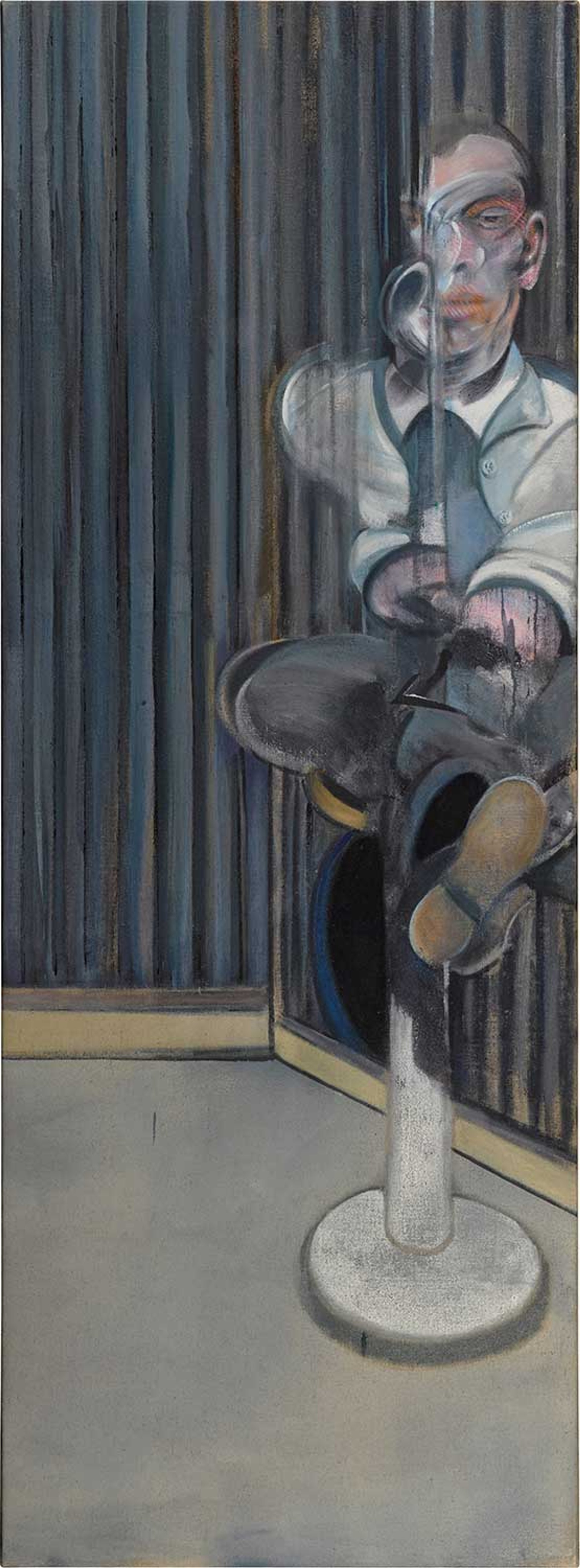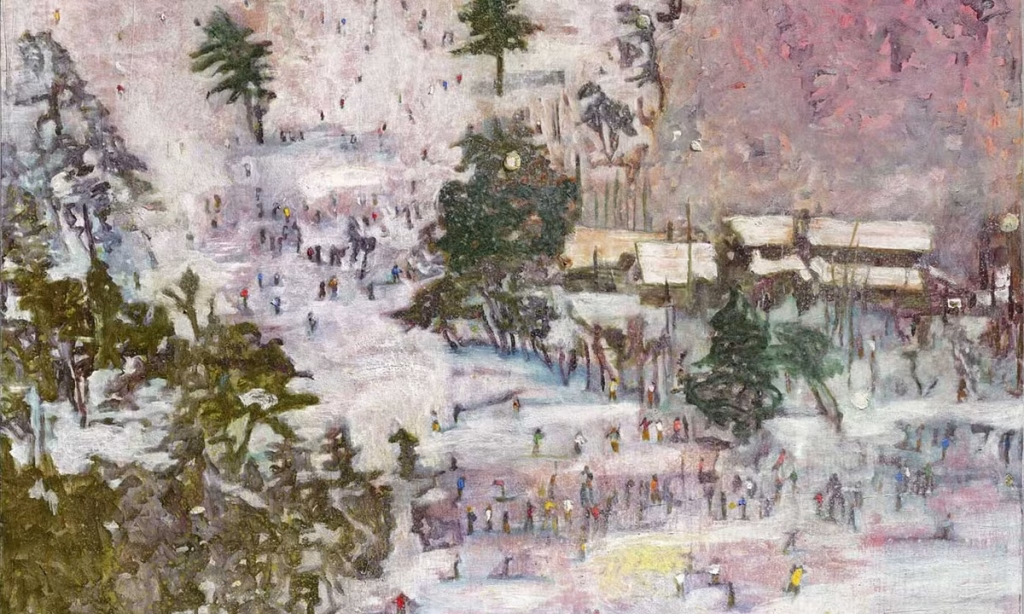Has the art market bounced off the bottom? Art market professionals and collectors were anxiously watching the results of the evening sales held during Frieze week, and hoping to see a recovery after two years of declining figures.
The picture was mixed, with a few highly desirable works performing splendidly, but more run-of-the-mill lots failing or going well under the already lowered pre-sale expectations. And there was a notable correction of prices for some artists whose values have tumbled over the past three or four years. But overall, the sale results brought some solace to the uneasy observers.
Images fail to convey how Doig makes the paint look like snow
Christie’s opened the ball with its 20th/21st-century evening sale on 15 October in a packed room, fielding a 61-lot session estimated at £87m-£129m, before fees. It proclaimed it was pleased with the results, which at £106.9m fell squarely within expectations and were 30% higher than those achieved in the slightly smaller equivalent sale last year.
Its headline lot was Peter Doig’s Ski Jacket (1994), which soared over its £6m-£8m estimate to make a stunning £14.2m after an epic—and excruciatingly slow—14-minute battle between the Hong Kong-based Eric Chang of Christie’s Asia and the final buyer in the room, the former Christie’s chairman Francis Outred, now an art dealer.
The Doig came from the famed Danish collector Ole Faarup (1934-2025), who had bought voraciously from artists in the early part of their careers, notably Warhol and Basquiat; eight of his acquisitions were in the evening sale, including four works by Doig. More of 140 lots from his collection will appear in further sales; the proceeds are going to a foundation to help young artists.
Ski Jacket did better than the following lot, Doig’s Country Rock (1998-99), showing a rainbow-painted tunnel glimpsed from a passing car. One of a series, it carried the higher target of £7m-£10m but hammered for £7.6m (£9.2m with fees). “Images fail to convey the impasto of Doig, how he makes the paint look like snow; people just love the plasticity of Ski Jacket,” said Katherine Arnold, head of post-war and contemporary art at Christie’s.
Adrien Meyer commanded the first half of Christie’s 20th/21st-century evening sale
Courtesy Christie’s
Other successes came for Paula Rego, Suzanne Valadon, Annie Morris and Esben Weile Kjær, who all achieved new auction highs. A Rego triptych, Dancing Ostriches from Walt Disney’s Fantasia (1995), showing boldly drawn dancers in various poses, made £3.5m; Valadon’s fleshy study Deux Nus (1923) achieved £1m (est. £600,000-£900,000); Morris’s Bronze Stack 9, Copper Blue (2015), a colourful totem of patinated metals, made £482,600 (est. £100,000-£150,000) while Kjær’s stained-glass work Aske and Johan upside down kissing in Power Play at Kunstforeningen GL STRAND (2020) made a within-estimate £25,400.
However, what became very clear, despite these records, were the new, very much reduced price levels of some of the works. In many cases the auctioneer—Adrien Meyer, for the first half of the sale—started off at prices well under the low estimate, even half in some cases. For example, the cover lot, an important but admittedly difficult Self-portrait Fragment (around 1956) by Lucian Freud, started at just £4.2m before hammering at £6.2m (£7.6m with fees)—under presale expectations of £8m-£12m. A Hirst medicine cabinet started at £300,000 and only achieved £508,000 with fees (est: £600,000-£900,000 without fees). Had the firm persuaded vendors to reduce their hopes in the run-up to the evening? The auction specialists were keeping schtum.
One picture, Nicolas Party’s Tree Trunks (2015), was withdrawn (“We chose to do so,” said Arnold) and five were bought in, including Yoshitomo Nara’s Haze Days (1998)—estimated at £6.5m-£8.5m. The Nara work had appeared on the market in 2023 in Sotheby’s “Now” evening sale, with a low estimate of $18m, but was withdrawn before the auction began. Even at the lowered estimate it failed to find a buyer.
Over half the sale—31 lots—carried guarantees, seven of them house, the remaining being third party.
The same rollercoaster ride happened at Sotheby’s evening sale on 16 October with pre-sale targets of £32.6m-£48.3m without fees, for 27 lots. Again with a packed audience, the sale raised £47.6m, towards the high end of expectations, and achieved a punchy £13.1m for Francis Bacon’s Portrait of a Dwarf (1975; est. £6m-£9m). This work was cut in two by the artist and the other half, showing caged lovers, was given to the writer Michael Peppiatt. It was the subject of a prolonged—17-minute—bidding war pitching at least four Sotheby’s specialists on the telephone against Emma Ward of Ward Moretti, who was finally outbid.

At Sotheby’s contemporary evening sale, Francis Bacon’s Portrait of a Dwarf (1975)—which the artist cut in two–sold for £13.11m, well above its £6m-£9m estimate
Courtesy Sotheby’s
(Lucy) Bull market
Also performing well was Lucy Bull’s large, red-hued abstract 9:59 (2021), which trounced its £300,000-£500,000 presale estimate to make £1.3m. There were 13 works bearing irrevocable bids and the only one with a house guarantee, Hurvin Anderson’s austere Marlene’s Big Sister (2006), was bought in. But some works—for example, Matthew Wong’s brightly coloured, semi-abstract The Visit (2017)—went well under estimate, in this case for £720,000 despite a target of £1.5m-£2m. Of the top-ten lots, seven carried third-party guarantees but only three—the Bacon, an Yves Klein and a Georg Baselitz—went over estimate.
“We are the most visible part of the market, and it gives us the opportunity to determine what values are today,” said Arnold of Christie’s: “And in some cases that means a correction in prices.”
